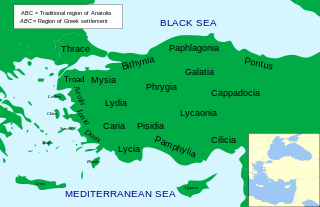This article has multiple issues. Please help improve it or discuss these issues on the talk page. (Learn how and when to remove these messages)
|

Classical Anatolia is Anatolia during classical antiquity. Early in that period, Anatolia was divided into several Iron Age kingdoms, most notably Lydia in the west, Phrygia in the center and Urartu in the east. Anatolia fell under Achaemenid Persian rule c. 550 BC. In the aftermath of the Greco-Persian Wars, all of Anatolia remained under Persian control except for the Aegean coast, which was incorporated in the Delian League in the 470s BC. Alexander the Great finally wrested control of the whole region from Persia in the 330s BC. After Alexander's death, his conquests were split amongst several of his trusted generals, but were under constant threat of invasion from both the Gauls and other powerful rulers in Pergamon, Pontus, and Egypt.
The Seleucid Empire, the largest of Alexander's territories, and which included Anatolia, became involved in a disastrous war with Rome culminating in the battles of Thermopylae and Magnesia. The resulting Treaty of Apamea in (188 BC) saw the Seleucids retreat from Anatolia. The Kingdom of Pergamum and the Republic of Rhodes, Rome's allies in the war, were granted the former Seleucid lands in Anatolia. Anatolia subsequently became contested between the neighboring rivalling Romans and the Parthian Empire, which frequently culminated in the Roman–Parthian Wars.
Anatolia came under Roman rule entirely following the Mithridatic Wars of 88–63 BC. Roman control of Anatolia was strengthened by a 'hands off' approach by Rome, allowing local control to govern effectively and providing military protection. In the early 4th century, Constantine the Great established a new administrative centre at Constantinople, and by the end of the 4th century a new eastern empire was established with Constantinople as its capital, referred to by historians as the Byzantine Empire from the original name, Byzantium.
In the subsequent centuries up to including the advent of the Early Middle Ages, the Parthians were succeeded by the Sasanian Persians, who would continue the centuries long rivalry between Rome and Persia, which again culminated in frequent wars on the eastern fringes of Anatolia. Byzantine Anatolia came under pressure of the Muslim invasion in the southeast, but most of Anatolia remained under Byzantine control until the Turkish invasion of the 11th century.